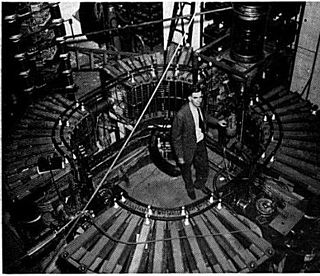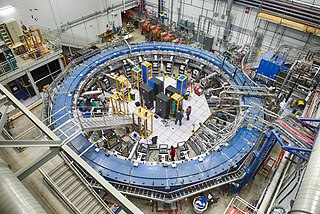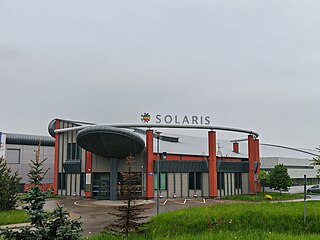Related Research Articles

A magnetic field is a physical field that describes the magnetic influence on moving electric charges, electric currents, and magnetic materials. A moving charge in a magnetic field experiences a force perpendicular to its own velocity and to the magnetic field. A permanent magnet's magnetic field pulls on ferromagnetic materials such as iron, and attracts or repels other magnets. In addition, a nonuniform magnetic field exerts minuscule forces on "nonmagnetic" materials by three other magnetic effects: paramagnetism, diamagnetism, and antiferromagnetism, although these forces are usually so small they can only be detected by laboratory equipment. Magnetic fields surround magnetized materials, electric currents, and electric fields varying in time. Since both strength and direction of a magnetic field may vary with location, it is described mathematically by a function assigning a vector to each point of space, called a vector field.

Brookhaven National Laboratory (BNL) is a United States Department of Energy national laboratory located in Upton, Long Island, a hamlet of the Town of Brookhaven. It was formally established in 1947 at the site of Camp Upton, a former U.S. Army base. Located approximately 60 miles east of New York City, it is managed by Stony Brook University and Battelle Memorial Institute.

A linear particle accelerator is a type of particle accelerator that accelerates charged subatomic particles or ions to a high speed by subjecting them to a series of oscillating electric potentials along a linear beamline. The principles for such machines were proposed by Gustav Ising in 1924, while the first machine that worked was constructed by Rolf Widerøe in 1928 at the RWTH Aachen University. Linacs have many applications: they generate X-rays and high energy electrons for medicinal purposes in radiation therapy, serve as particle injectors for higher-energy accelerators, and are used directly to achieve the highest kinetic energy for light particles for particle physics.

A synchrotron light source is a source of electromagnetic radiation (EM) usually produced by a storage ring, for scientific and technical purposes. First observed in synchrotrons, synchrotron light is now produced by storage rings and other specialized particle accelerators, typically accelerating electrons. Once the high-energy electron beam has been generated, it is directed into auxiliary components such as bending magnets and insertion devices in storage rings and free electron lasers. These supply the strong magnetic fields perpendicular to the beam that are needed to stimulate the high energy electrons to emit photons.

A synchrotron is a particular type of cyclic particle accelerator, descended from the cyclotron, in which the accelerating particle beam travels around a fixed closed-loop path. The magnetic field which bends the particle beam into its closed path increases with time during the accelerating process, being synchronized to the increasing kinetic energy of the particles.

The National High Magnetic Field Laboratory (MagLab) is a facility at Florida State University, the University of Florida, and Los Alamos National Laboratory in New Mexico, that performs magnetic field research in physics, biology, bioengineering, chemistry, geochemistry, biochemistry. It is the only such facility in the US, and is among twelve high magnetic facilities worldwide. The lab is supported by the National Science Foundation and the state of Florida, and works in collaboration with private industry.
Victor John Emery was a British specialist on superconductors and superfluidity. His model for the electronic structure of the copper-oxide planes is the starting point for many analyses of high-temperature superconductors and is commonly known as the Emery model.
The National Synchrotron Light Source (NSLS) at Brookhaven National Laboratory (BNL) in Upton, New York was a national user research facility funded by the U.S. Department of Energy (DOE). Built from 1978 through 1984, and officially shut down on September 30, 2014, the NSLS was considered a second-generation synchrotron.

The Advanced Light Source (ALS) is a research facility at Lawrence Berkeley National Laboratory in Berkeley, California. One of the world's brightest sources of ultraviolet and soft x-ray light, the ALS is the first "third-generation" synchrotron light source in its energy range, providing multiple extremely bright sources of intense and coherent short-wavelength light for use in scientific experiments by researchers from around the world. It is funded by the US Department of Energy (DOE) and operated by the University of California. The current director is Dimitri Argyriou.
Joachim Stöhr is a physicist and professor emeritus of the Photon Science Department of Stanford University. His research has focused on the development of X-ray and synchrotron radiation techniques and their applications in different scientific fields with emphasis on surface science and magnetism. During his career he also held several scientific leadership positions, such as the director of the Stanford Synchrotron Radiation Laboratory (SSRL) and he was the founding director of the Linac Coherent Light Source (LCLS), the world's first x-ray free electron laser.

The European X-Ray Free-Electron Laser Facility is an X-ray research laser facility commissioned during 2017. The first laser pulses were produced in May 2017 and the facility started user operation in September 2017. The international project with twelve participating countries; nine shareholders at the time of commissioning, later joined by three other partners, is located in the German federal states of Hamburg and Schleswig-Holstein. A free-electron laser generates high-intensity electromagnetic radiation by accelerating electrons to relativistic speeds and directing them through special magnetic structures. The European XFEL is constructed such that the electrons produce X-ray light in synchronisation, resulting in high-intensity X-ray pulses with the properties of laser light and at intensities much brighter than those produced by conventional synchrotron light sources.

A particle accelerator is a machine that uses electromagnetic fields to propel charged particles to very high speeds and energies to contain them in well-defined beams. Small accelerators are used for fundamental research in particle physics. Accelerators are also used as synchrotron light sources for the study of condensed matter physics. Smaller particle accelerators are used in a wide variety of applications, including particle therapy for oncological purposes, radioisotope production for medical diagnostics, ion implanters for the manufacture of semiconductors, and accelerator mass spectrometers for measurements of rare isotopes such as radiocarbon.

The National Synchrotron Light Source II (NSLS-II) at Brookhaven National Laboratory (BNL) in Upton, New York is a national user research facility funded primarily by the U.S. Department of Energy's (DOE) Office of Science. NSLS-II is a synchrotron light source, designed to produce X-rays 10,000 times brighter than BNL's original light source, the National Synchrotron Light Source (NSLS). NSLS-II supports research in energy security, advanced materials synthesis and manufacturing, environment, and human health.
An energy recovery linac (ERL) is a type of linear particle accelerator that provides a beam of electrons used to produce x-rays by synchrotron radiation. First proposed in 1965 the idea gained interest since the early 2000s.
The index of physics articles is split into multiple pages due to its size.
Stephen Douglas Kevan is an American condensed matter physicist who researches "surface and thin film physics; electronic structure and collective excitations at surfaces; nanoscale spatial and temporal fluctuations in magnetic and other complex materials". He is the current director of the Advanced Light Source (ALS) at Lawrence Berkeley National Laboratory in Berkeley, California. He is also a faculty member on leave from the University of Oregon and served as division deputy for science at the ALS prior to his directorship.

Muon g − 2 is a particle physics experiment at Fermilab to measure the anomalous magnetic dipole moment of a muon to a precision of 0.14 ppm, which is a sensitive test of the Standard Model. It might also provide evidence of the existence of new particles.

SOLARIS is a synchrotron light source in the city of Kraków in Poland. It is the only one facility of its kind in Central-Eastern Europe. Built in 2015, under the auspices of the Jagiellonian University, it is located on the Campus of the 600th Anniversary of the Jagiellonian University Revival, in the southern part of the city. It is the central facility of the National Synchrotron Radiation Centre SOLARIS.
Elaine DiMasi is an American physicist and a staff scientist at Lawrence Berkeley National Laboratory, where she is the project lead of the optical systems for the upgrade of the Advanced Light Source.

Laura Henderson Lewis is an American electronic materials scientist and engineer. She is a distinguished university professor at Northeastern University, having previously served as the department chair of Northeastern University's chemical engineering department. Prior to her Northeastern University position, she was a research group leader and associate department chair in the nanoscience department of Brookhaven National Laboratory (BNL).
References
- 1 2 Ring Leader: Elke Arenholz, Senior Scientist, Scientific Support Group – ALS News, Lawrence Berkeley National Laboratory
- ↑ Magnetism as seen with X‐Rays
- 1 2 3 4 Elke Arenholz Named Director of the National Synchrotron Light Source II at Brookhaven
- ↑ "Ring Leader: Elke Arenholz, Senior Scientist, Scientific Support Group". ALS. 2012-10-30. Retrieved 2022-03-20.
- ↑ CHESS Welcomes Elke Arenholz as New Associate Director – Cornell High Energy Synchrotron Source
- ↑ APS Fellow Archive (2014) – American Physical Society
- ↑ "2024 Fellow Class" (PDF). IEEE. Retrieved 2023-12-10.
- ↑ "BNL | Staff | Elke Arenholz, National Synchrotron Light Source II". www.bnl.gov. Retrieved 2024-09-06.